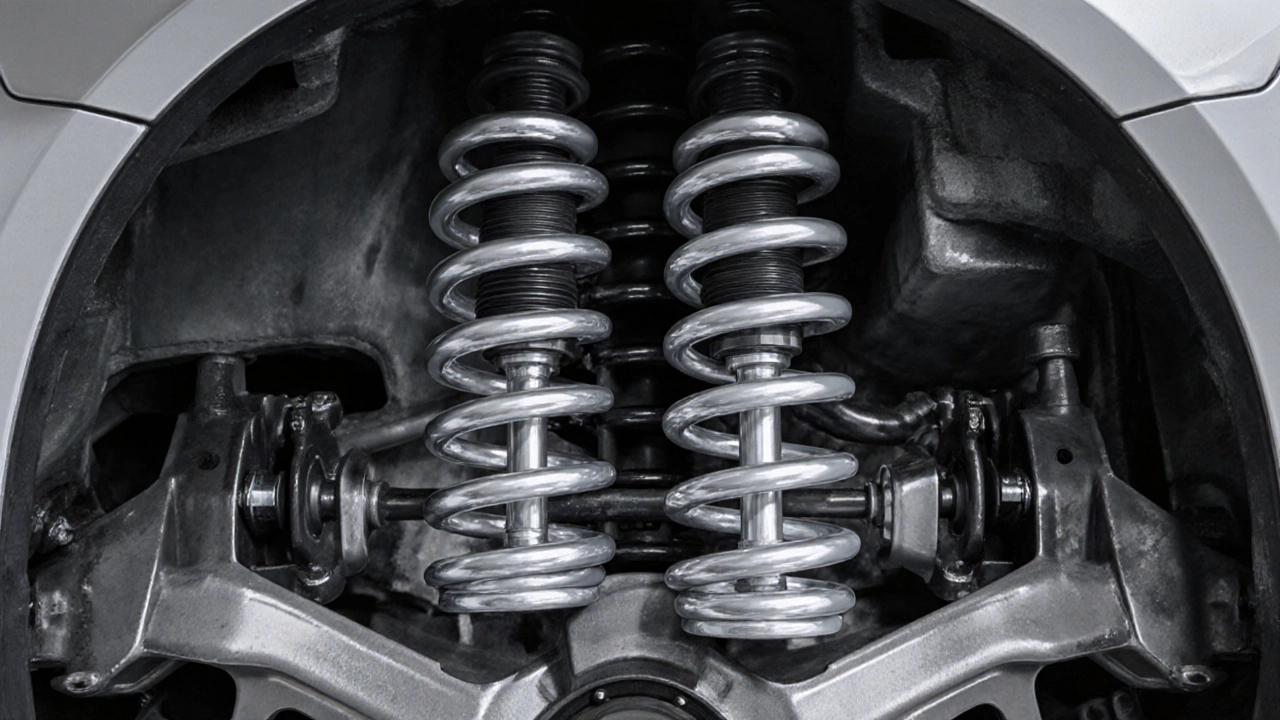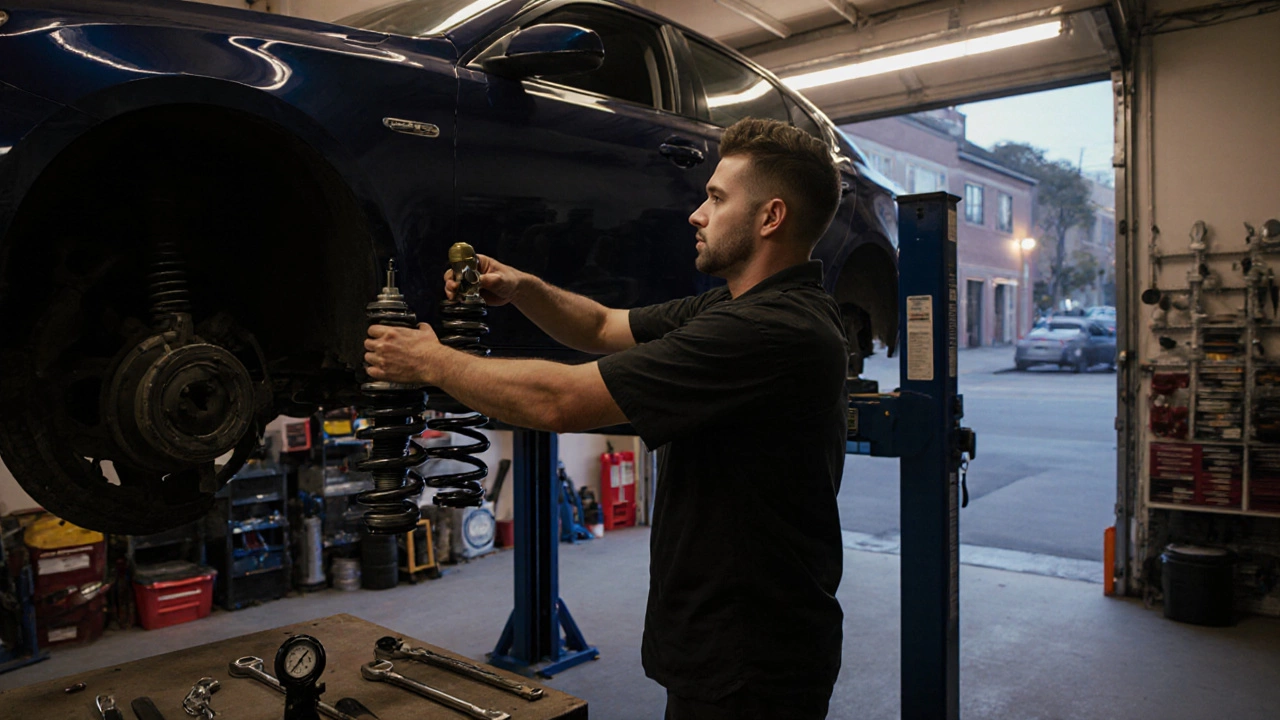Spring Rate Calculator
Calculate Your Ideal Spring Rate
Determine the appropriate spring rate for your vehicle based on weight and desired ride height drop. The calculator follows industry standards for daily driving suitability.
Recommended Spring Rate
Based on article guidelines: 1.2-1.5 lb/in per 100 lbs of vehicle mass.
For daily driving, we recommend staying within the mild lowering range.
Many car fans wonder if lowering springs can be a sensible choice for a vehicle you drive to work, school, or the grocery store every day. The short answer is: they can work, but you need to understand the trade‑offs. This guide breaks down how lowering springs affect ride height, handling, comfort, and long‑term wear, so you can decide whether they fit your daily routine.
What Exactly Are Lowering Springs?
Lowering Springs are aftermarket coil springs that have a higher spring rate than the factory‑fitted stock springs. By being stiffer and often shorter, they pull the chassis closer to the ground, reducing the factory ride height by anywhere from 0.5 to 2 inches. The result is a more aggressive stance and a shift in the suspension geometry that can improve cornering grip, but it also changes how the car reacts to bumps and potholes.
How Do They Change Your Car’s Dynamics?
When you drop the ride height, several things happen at once:
- Lower Center of Gravity: The mass sits closer to the ground, which can reduce body roll during cornering.
- Stiffer Spring Rate: A higher spring rate means the suspension compresses less under load, sharpening the feel of the steering.
- Altered Alignment Angles: Camber and caster values shift, often giving more negative camber at the corners, which improves tire contact patch.
These changes can make the car feel more planted on winding roads, but they also reduce the ability of the suspension to absorb larger road imperfections.
Benefits for Everyday Driving
Even if you’re not a track day regular, lowering springs can bring tangible perks:
- Improved Aesthetics: A lower stance gives a sportier look that many owners find rewarding.
- Better Handling in Light Corners: The reduced roll and enhanced camber can make everyday lane changes feel tighter.
- Reduced Aerodynamic Drag: A lower profile can shave a few tenths of a coefficient, modestly improving fuel economy at highway speeds.
For city commuters who enjoy a responsive feel, these positives can outweigh the downsides if the setup is done correctly.
Potential Drawbacks on the Road
While the look and sharper turn‑in are attractive, there are real compromises you’ll notice on a regular commute:
- Ride Comfort: Stiffer springs transmit more road noise and vibrations into the cabin, especially over potholes.
- Increased Tire Wear: The altered camber can cause uneven tread wear if alignment isn’t retuned.
- Suspension Component Stress: Harder springs place extra load on shock absorbers and mounting points, potentially shortening their lifespan.
- Ground Clearance Issues: With a reduced ride height, speed bumps, steep drive‑throughs, and uneven parking lots become real hazards.
If you regularly drive on rough streets or encounter frequent speed bumps, these factors can turn a fun modification into a daily annoyance.
Key Considerations Before You Lower
To keep the daily driver experience pleasant, evaluate these variables:
- Spring Rate Selection: Choose a rate that matches your vehicle weight. A typical rule‑of‑thumb is 1.2 lb/in per 100 lb of vehicle mass for mild lowering, up to 1.5 lb/in for aggressive drops.
- Matching Shock Absorbers: Pairing stiff springs with performance shocks (or adjustable coil‑over kits) preserves ride quality.
- Alignment Check: After installation, have an alignment shop adjust camber, caster, and toe to factory specifications or the new target values.
- Tire Choice: Low‑profile tires can mask some of the harshness, but they may also be more prone to damage on rough roads.
- Anti‑Roll Bar Tuning: Thicker or adjustable anti‑roll bars help control body roll without relying solely on spring stiffness.
Skipping any of these steps often leads to an uncomfortable ride, premature wear, or unsafe handling.

Installation & Maintenance Checklist
Following a systematic approach makes the process smoother and reduces surprises:
- Gather required tools: spring compressors, torque wrench, jack stands.
- Lift the vehicle safely and remove the wheels.
- Compress the existing stock springs and detach them from the strut towers.
- Install the lowering springs, ensuring proper seating on both top and bottom mounts.
- Reinstall wheels, lower the car, and torque all fasteners to manufacturer specs.
- Get a professional alignment (focus on camber and toe).
- Inspect for any rubbing on the under‑carriage, especially during full lock turns.
- Monitor tire wear for the first 500 miles; adjust alignment if uneven patterns appear.
Regularly checking for squeaks or clunk sounds can catch early wear on shock absorbers or mounting brackets.
Stock vs. Lowering Springs: Quick Comparison
| Attribute | Stock Springs | Lowering Springs |
|---|---|---|
| Ride Height Change | Factory spec | -0.5 to -2.0 inches |
| Spring Rate | Standard (1.0 lb/in per 100 lb) | 1.2-1.5 lb/in per 100 lb |
| Handling | Comfort‑oriented | Sharper turn‑in, reduced roll |
| Ride Comfort | Soft, absorbs bumps | Stiffer, more road feedback |
| Alignment Sensitivity | Low | High - requires professional alignment |
| Typical Use Cases | Daily driver, family cars | Enthusiast daily driver, light track |
When Are Lowering Springs the Right Choice?
Summarize the scenarios where the benefits outweigh the downsides:
- Mostly smooth‑paved roads with occasional spirited driving.
- Desire for a sportier look without major budget for a full coil‑over system.
- Willingness to invest in proper alignment and periodic suspension checks.
If you regularly tackle pothole‑filled streets, carry heavy loads, or need maximum comfort for long trips, sticking with stock springs or opting for a mild adjustable coil‑over setup may be wiser.
Will lowering springs damage my car’s suspension?
If installed correctly and paired with appropriate shocks, they won’t damage components. However, a mismatched spring rate can over‑stress mounts and fasteners, leading to premature wear.

Do I need to realign my car after installing lowering springs?
Yes. The change in ride height alters camber and caster, so a professional alignment is essential to maintain tire life and safe handling.
How much will a set of lowering springs cost?
Prices vary by brand and vehicle, but expect $100-$300 for a set of four. Installation labor can add $150-$300 if you’re not doing it yourself.
Will lowering springs affect my fuel economy?
The impact is modest. A lower aerodynamic profile may shave 0.5-1 % off highway fuel use, but stiffer springs can increase rolling resistance, often canceling out the gain.
Can I combine lowering springs with aftermarket wheels?
Yes, but ensure the new wheel’s offset and diameter don’t cause rubbing. A slight increase in wheel offset can compensate for the reduced clearance from the lower stance.
Is a full coil‑over kit better than lowering springs for daily use?
Coil‑overs offer adjustable ride height and damping, giving you flexibility to dial in comfort or performance. They’re pricier, but they eliminate many of the compromises of fixed lowering springs.




